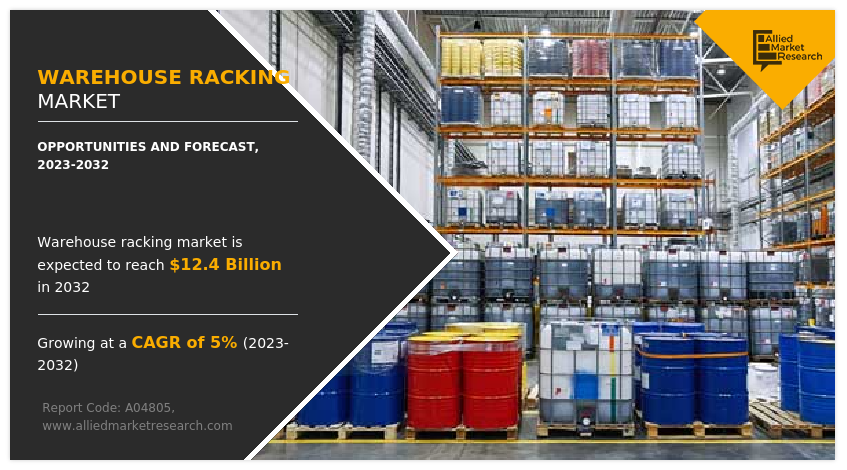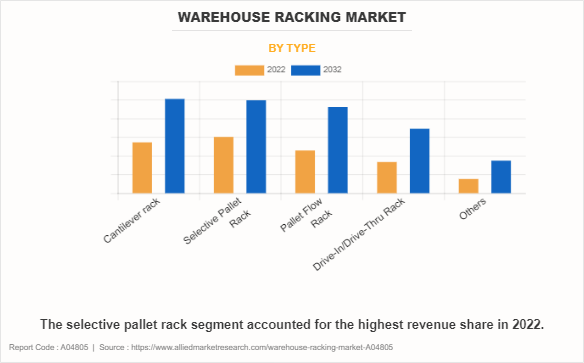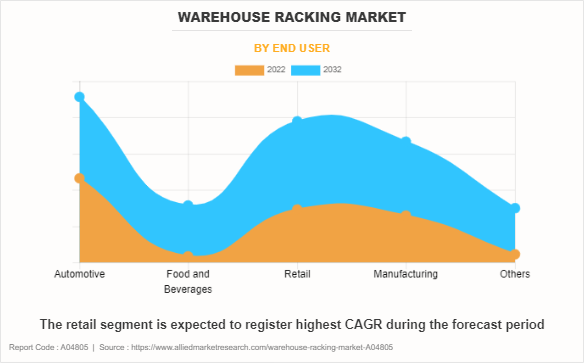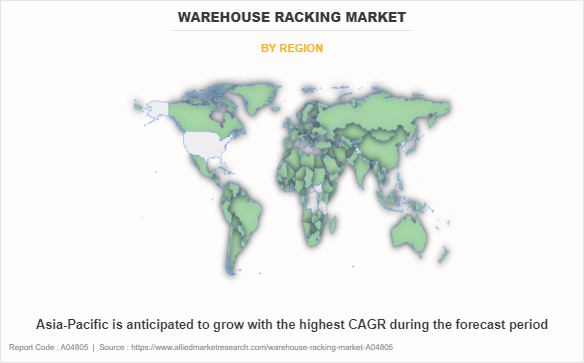Warehouse Racking Market Research: 2032
The Global Warehouse Racking Market Size was valued at $7.7 billion in 2022, and is projected to reach $12.4 billion by 2032, growing at a CAGR of 5% from 2023 to 2032. Warehouse racking, often referred to as pallet racking, is a method of efficiently organizing and storing goods in a warehouse or distribution facility. This system employs vertical frames, horizontal beams, and shelving to create multiple storage levels for palletized merchandise, maximizing space utilization and enabling convenient retrieval of stored items.

Market Dynamics
Globalization has a significant impact on the dynamics and requirements of modern distribution and warehousing, which in turn drives the market for warehouse racking. The demand for effective storage solutions rises in parallel with the globalization of the economy, cross-border supply chain expansion, and expansion of international trade. Numerous significant aspects of globalization serve as drivers for the warehouse racking market. Furthermore, specialized storage systems are necessary due to the complexity of international logistics, which involves products arriving from various regions and transferring to different markets. Pallet flow racks, automated storage and retrieval systems, and high-density racking are essential tools for handling the complexity of international supply chains. These factors are expected to drive the warehouse racking market during the forecast period.
E-commerce is expanding at a rate that warehouses must operate at a never-before-seen scale and speed. Distribution facilities have grown in terms of geographic area and operational complexity as more customers prefer to purchase online. Pallet flow racking and automated storage and retrieval systems (AS/RS) are two examples of high-density storage systems that are essential for optimizing storage capacity and ensuring precise and quick order pickup.
High initial investment is expected to restrain the warehouse racking market growth and have a negative impact on the warehouse racking market outlook. Smaller and newly established enterprises find this cost barrier particularly challenging, which makes it difficult for them to compete successfully in the market and maximize their storage capacity. Although there are used racking solutions and more affordable options, there may be issues with the dependability and quality of these systems. Therefore, resolving this issue through the promotion of affordable options, financing schemes, or incentives for energy-efficient designs is essential for the market for warehouse racking to grow sustainably.
The market for warehouse racking is expected to grow significantly as a result of the globalization of supply chains and logistics. The need for effective storage solutions is growing with enterprises' increased sourcing and distribution of goods across international borders. Warehouse racking solutions play a critical role in maximizing the use of available storage space and simplifying the flow of goods in complicated, international supply chains. Furthermore, to lower transportation costs and lead times, global supply chains frequently need regional hubs and strategic distribution centers.
This creates a requirement for sophisticated racking configurations that can handle a variety of product lines and adjust to changing local needs. Specialized racking systems are also required as a result of this increase for industries including electronics, automobiles, and pharmaceuticals, each of which has different storage needs. Such trends are expected to drive the warehouse racking market and offer lots of growth opportunities during the forecast period.
Segmental Overview
The warehouse racking market is segmented on the basis of type, carrying capacity, end user, and region. On the basis of type, the market is segmented into cantilever rack, selective pallet rack, pallet flow rack, drive-in/drive-thru rack, and others. On the basis of carrying capacity, the market is divided into light duty, medium duty, and heavy duty. On the basis of end user, the market is divided into automotive, food and beverages, retail, manufacturing, and others.
On the basis of region, the market is analyzed across North America (the U.S., Canada, and Mexico), Europe (Germany, the UK, Italy, France, and rest of Europe), Asia-Pacific (China, Japan, India, South Korea, and rest of Asia-Pacific), and LAMEA (Latin America, Middle East, Africa).

By Type:
The warehouse racking market is divided into cantilever rack, selective pallet rack, pallet flow rack, drive-in/drive-thru rack, and others. Selective pallet rack is a type of industrial storage system designed to efficiently store and retrieve palletized goods in warehouses. It consists of vertical frames and horizontal beams with adjustable heights, allowing for the selective placement of pallets on multiple levels. Pallet flow rack, also known as gravity flow rack, is a storage system designed for efficient inventory management. It employs inclined rollers or wheels to enable pallets to flow by gravity from the loading end to the unloading end, ensuring first-in, first-out (FIFO) access and optimizing space utilization in warehouses and distribution centers.
Cantilever rack is a specialized storage system designed for the organized and accessible storage of long and bulky items, such as pipes, lumber, and steel bars. Drive-in/drive-thru rack is a specialized warehouse storage system designed for high-density storage of palletized goods. It features a series of deep storage lanes accessible by forklifts, allowing them to drive into the rack to place or retrieve pallets. The others segment includes narrow aisle racking systems, double deep pallet racking, mobile pallet racking, and push-back racking.
The selective pallet rack segment is expected to exhibit the largest revenue contributor during the forecast period. The pallet flow rack segment is expected to exhibit the highest CAGR share in the type segment in the warehouse racking market during the forecast period.

By Carrying Capacity:
The warehouse racking market is bifurcated into light duty, medium duty, and heavy duty. The racking system with a capacity of up to 2000 kg is considered in the light duty segment. Medium duty racking system include the capacity from 2000 kg to 8000kg. The racking system with a capacity of more than 8000kg is considered in heavy duty segment.
The heavy-duty warehouse racking segment is expected to be the largest revenue contributor during the forecast period, and the medium-duty segment is expected to exhibit the highest CAGR share in the carrying capacity segment in the warehouse racking market during the forecast period.

By End User:
The warehouse racking market is divided into automotive, food and beverages, retail, manufacturing, and others. The food and beverages industry includes all those companies that are involved in the processing of raw food and drinking materials. Most of them are also involved in its packaging and distribution. Warehouse racking is used in the retail industry to efficiently store and manage a wide range of products. It optimizes storage space, facilitates easy access, and enhances inventory organization, resulting in quicker restocking, reduced product damage, and improved customer service by ensuring items are readily available for purchase. Warehouse racking is crucial in the manufacturing industry as it provides an efficient and organized way to store raw materials, work-in-progress, and finished products. This segment includes the textile, logistics, and aerospace industries.
The automotive segment is expected to be the largest revenue contributor during the forecast period, and the retail segment is expected to exhibit the highest CAGR share in the end user segment in the warehouse racking market during the forecast period.

By Region:
The warehouse racking market is analyzed across North America (the U.S., Canada, and Mexico), Europe (Germany, the UK, Italy, France, and rest of Europe), Asia-Pacific (China, Japan, India, South Korea, and rest of Asia-Pacific), and LAMEA (Latin America, Middle East, Africa). In 2022, North America had the highest revenue in warehouse racking market share, and Asia-Pacific is expected to exhibit the highest CAGR during the forecast period.
Competition Analysis
The major players profiled in the warehouse racking market Daifuku Co., Ltd., BEUMER GROUP, Dematic Corporation, Dexion, Godrej Group, Interroll Holding AG, SSI SCHAFER, Steel King Industries, Inc., TOYOTA INDUSTRIES CORPORATION, and Warehouse Rack & Shelf LLC.
Major companies in the market have adopted product launches, business expansion, and other strategies as their key developmental strategies to offer better products and services to customers in the warehouse racking market.
Some examples of expansion and product launch on the market.
In September 2023, KION Group has completed one of the largest automation projects in Slovakia for the automotive supplier ZKW, which is situated in Central Europe. Pallet stackers move down the aisles, pallets are organized automatically, conveyor belts move small load carriers, and product quality is checked in the middle of it all. To supervise and manage the fully automated operation, just one individual is required every shift.
In December 2021, Godrej & Boyce, announced plans lined up for warehouse digital operation to increase efficiency. Improving logistics or intralogistics space, digitally enabling warehouse operation, and other plans will increase the efficiency, reduce the cost of operation and time of delivery.
In May 2023, Steel King Industries, Inc. set up a new headquarters at Stevens Point, WI. The new headquarters is almost 3 times larger than the old headquarters. This will help the company in showcasing its products and services in a better way.
In August 2021, Dexion Group launched a brand new mobile pallet racking named MOVO 3015. Which is equipped with a high load-bearing capacity of approximately 60 tons per back-to-back bay.
In February 2021, Dexion Group launched a new generation medium-duty cantilever racking system. It has an armload carrying capacity of approximately 1195 kg and a column load capacity of approximately 4780 kg.
In September 2021, Gonvarri Material Handling (GMH) subsidiary, Dexion Romania, which is one of the group's primary pallet racking production, engineering, and product development based in Europe, is planning to business expansion. The development and production hub are expected to grow by more than 35%.
Key Benefits for Stakeholders
- The report provides an extensive analysis of the current and emerging warehouse racking market trends and dynamics.
- In-depth warehouse racking market analysis is conducted by constructing market estimations for key market segments between 2022 and 2032.
- Extensive analysis of the warehouse racking market is conducted by following key product positioning and monitoring of top competitors within the market framework.
- A comprehensive analysis of all the regions is provided to determine the prevailing opportunities.
- The warehouse racking market forecast analysis from 2023 to 2032 is included in the report.
- The key players within the warehouse racking market are profiled in this report and their strategies are analyzed thoroughly, which helps us understand the competitive outlook of the warehouse racking industry.
Warehouse Racking Market Report Highlights
| Aspects | Details |
| Market Size By 2032 | USD 12.4 billion |
| Growth Rate | CAGR of 5% |
| Forecast period | 2022 - 2032 |
| Report Pages | 204 |
| By Type |
|
| By End User |
|
| By Carrying Capacity |
|
| By Region |
|
| Key Market Players | Dematic Corporation, SSI SCHAFER, Toyota Industries Corporation, Interroll Holding AG, Warehouse Rack & Shelf LLC, Steel King Industries, Inc., Dexion Group, Godrej Group, BEUMER Group, Daifuku Co., Ltd. |
Analyst Review
The warehouse racking market has witnessed significant growth in past few years, owing to surge in purchase from online-channels. The market is experiencing growth, owing to rise in global trade and increase in disposable income. This increases the profitability of warehouses. Developed countries such as U.S., and Canada, which already have a highly developed e-commerce, and industrial sectors are leading the warehouse racking market.
In addition, governments in developing countries have implemented various policies for development of the industrial sector. Since industries make significant use of warehouses for storage of raw materials and finished products, the growth of industries is expected to drive the growth of the warehouse racking market. Moreover, advancements in artificial intelligence, and communication protocols are anticipated to make automation efficient. This is anticipated to provide lucrative opportunities for market growth.
The growth of the e-commerce industry, and the rapidly increasing volume of inventory owing to increasing global trade drive the growth of the global warehouse racking market.
The latest version of the global warehouse racking market report can be obtained on demand from the website.
The global warehouse racking market size was valued at $7.7 billion in 2022.
The global warehouse racking market size is estimated to reach $12.4 billion by 2032, exhibiting a CAGR of 5.0% from 2023 to 2032.
The forecast period considered for the global warehouse racking market is 2023 to 2032, wherein, 2022 is the base year, 2023 is the estimated year, and 2032 is the forecast year.
North America is the largest regional market for warehouse racking market.
Key companies profiled in the warehouse racking market report include Daifuku Co., Ltd., BEUMER GROUP, Dematic Corporation, Dexion, Godrej Group, Interroll Holding AG, SSI SCHAFER, Steel King Industries, Inc., TOYOTA INDUSTRIES CORPORATION, and Warehouse Rack & Shelf LLC.
The report contains an exclusive company profile section, where leading companies in the market are profiled. These profiles typically cover company overview, geographical presence, market dominance (in terms of revenue and volume sales), various strategies, and recent developments.
Loading Table Of Content...
Loading Research Methodology...



